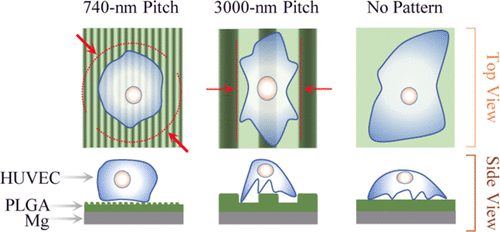当前位置:
X-MOL 学术
›
ACS Biomater. Sci. Eng.
›
论文详情
Our official English website, www.x-mol.net, welcomes your feedback! (Note: you will need to create a separate account there.)
Engineering Nano-to-Micron-Patterned Polymer Coatings on Bioresorbable Magnesium for Controlling Human Endothelial Cell Adhesion and Morphology
ACS Biomaterials Science & Engineering ( IF 5.8 ) Pub Date : 2020-05-22 , DOI: 10.1021/acsbiomaterials.0c00642 Wensen Jiang 1 , Chaoxing Zhang 1 , Larry Tran 2, 3 , Sebo Gene Wang 2, 4 , Ammar Dilshad Hakim 2 , Huinan Liu 1, 2
ACS Biomaterials Science & Engineering ( IF 5.8 ) Pub Date : 2020-05-22 , DOI: 10.1021/acsbiomaterials.0c00642 Wensen Jiang 1 , Chaoxing Zhang 1 , Larry Tran 2, 3 , Sebo Gene Wang 2, 4 , Ammar Dilshad Hakim 2 , Huinan Liu 1, 2
Affiliation

|
Surface patterning is an attractive approach to modify the surface of biomaterials for modulating cell activities and enhancing the performance of medical implants without involving typical chemical changes to the implants such as adding growth factors, antibiotics, and drugs. In this study, nano-to-micron patterns were engineered on thermoplastic and thermoset polymer coatings on bioresorbable magnesium (Mg) substrates to control the cellular responses and material degradation for vascular applications. Capillary force lithography (CFL) was modified and integrated with spray coating to fabricate well-aligned nano-to-micron patterns on the thermoplastic poly(lactic-co-glycolic acid) (PLGA) and thermoset poly(glycerol sebacate) (PGS) coatings on Mg substrates. Specifically, a new process of molding-curing CFL was revised from the conventional CFL to successfully create nano-to-submicron patterns on thermoset PGS for the first time. The nano-to-micron-patterned polymer coatings of PLGA and PGS on Mg were carefully characterized, and their effects on cell adhesion and morphology were investigated through direct culture with human umbilical vein endothelial cells (HUVECs) in vitro. The results showed that the 3000 nm parallel grooves could effectively elongate the HUVECs, while the 740 nm parallel grooves tended to reduce the spreading of HUVECs. The PLGA coatings reduced the degradation of Mg substrates more than that of the PGS coatings in the direct culture with HUVECs in vitro. CFL-based methods coupled with spray coating should be further studied as a nonchemical approach for creating nano-to-micron-patterned polymer coatings on Mg-based substrates of various sizes and shapes, which may present a new direction for improving the performance of Mg-based bioresorbable vascular devices toward potential clinical translation.
中文翻译:

在可生物吸收的镁上设计纳米到微米图案的聚合物涂层,以控制人类内皮细胞的粘附和形态。
表面图案化是一种有吸引力的方法,可以修饰生物材料的表面来调节细胞活性并增强医疗植入物的性能,而无需对植入物进行典型的化学变化,例如添加生长因子,抗生素和药物。在这项研究中,在生物可吸收镁(Mg)基体上的热塑性和热固性聚合物涂层上设计了纳米到微米图案,以控制细胞响应和血管降解材料的降解。毛细管力光刻(CFL)进行了修改,并与喷涂工艺集成在一起,以在热塑性聚乳酸共聚物上制造出排列整齐的纳米至微米图案-乙醇酸(PLGA)和热固性聚癸二酸甘油酯(PGS)涂层。具体而言,从传统的CFL修改了一种模制CFL的新工艺,以首次成功在热固性PGS上成功创建从纳米到亚微米的图案。仔细表征了PLGA和PGS在Mg上的纳米级至微米级聚合物涂层,并通过在体外与人脐静脉内皮细胞(HUVECs)直接培养研究了它们对细胞粘附和形态的影响。结果表明,3000 nm的平行沟槽可以有效地延长HUVEC,而740 nm的平行沟槽则倾向于减少HUVEC的扩散。与HUVECs体外直接培养相比,PLGA涂层比MGS涂层更能减少Mg底物的降解。
更新日期:2020-07-13
中文翻译:

在可生物吸收的镁上设计纳米到微米图案的聚合物涂层,以控制人类内皮细胞的粘附和形态。
表面图案化是一种有吸引力的方法,可以修饰生物材料的表面来调节细胞活性并增强医疗植入物的性能,而无需对植入物进行典型的化学变化,例如添加生长因子,抗生素和药物。在这项研究中,在生物可吸收镁(Mg)基体上的热塑性和热固性聚合物涂层上设计了纳米到微米图案,以控制细胞响应和血管降解材料的降解。毛细管力光刻(CFL)进行了修改,并与喷涂工艺集成在一起,以在热塑性聚乳酸共聚物上制造出排列整齐的纳米至微米图案-乙醇酸(PLGA)和热固性聚癸二酸甘油酯(PGS)涂层。具体而言,从传统的CFL修改了一种模制CFL的新工艺,以首次成功在热固性PGS上成功创建从纳米到亚微米的图案。仔细表征了PLGA和PGS在Mg上的纳米级至微米级聚合物涂层,并通过在体外与人脐静脉内皮细胞(HUVECs)直接培养研究了它们对细胞粘附和形态的影响。结果表明,3000 nm的平行沟槽可以有效地延长HUVEC,而740 nm的平行沟槽则倾向于减少HUVEC的扩散。与HUVECs体外直接培养相比,PLGA涂层比MGS涂层更能减少Mg底物的降解。



























 京公网安备 11010802027423号
京公网安备 11010802027423号